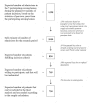Cost-effectiveness of the Australian Medical Sheepskin for the prevention of pressure ulcers in somatic nursing home patients: study protocol for a prospective multi-centre randomised controlled trial (ISRCTN17553857)
- PMID: 18179714
- PMCID: PMC2245931
- DOI: 10.1186/1472-6963-8-4
Cost-effectiveness of the Australian Medical Sheepskin for the prevention of pressure ulcers in somatic nursing home patients: study protocol for a prospective multi-centre randomised controlled trial (ISRCTN17553857)
Abstract
Background: Pressure ulcers are a major problem, especially in nursing home patients, although they are regarded as preventable and there are many pressure relieving methods and materials. One such pressure relieving material is the recently developed Australian Medical Sheepskin, which has been shown in two randomized controlled trials 12 to be an effective intervention in the prevention of sacral pressure ulcers in hospital patients. However, the use of sheepskins has been debated and in general discouraged by most pressure ulcer working groups and pressure ulcer guidelines, but these debates were based on old forms of sheepskins. Furthermore, nothing is yet known about the (cost-)effectiveness of the Australian Medical sheepskin in nursing home patients. The objective of this study is to assess the effects and costs of the use of the Australian Medical Sheepskin combined with usual care with regard to the prevention of sacral pressure ulcers in somatic nursing home patients, versus usual care only.
Methods/design: In a multi-centre randomised controlled trial 750 patients admitted for a primarily somatic reason to one of the five participating nursing homes, and not having pressure ulcers on the sacrum at admission, will be randomized to either usual care only or usual care plus the use of the Australian Medical Sheepskin as an overlay on the mattress. Outcome measures are: incidence of sacral pressure ulcers in the first month after admission; sacrum pressure ulcer free days; costs; patient comfort; and ease of use. The skin of all the patients will be observed once a day from admission on for 30 days. Patient characteristics and pressure risk scores are assessed at admission and at day 30 after it. Additional to the empirical phase, systematic reviews will be performed in order to obtain data for economic weighting and modelling. The protocol is registered in the Controlled Trial Register as ISRCTN17553857.
Figures
References
-
- McGowan S, Montgomery KC, Jolley DJ, Wright R. The role of sheepskins in preventing pressure ulcers in elderly orthopaedic patients. Primary Intention. 2000;8:127–134.
-
- Jolley DJ, Wright R, McGowan S, Hickey MB, Campbell DA, Sinclair RD, Montgomery KC. Preventing pressure ulcers with the Australian Medical Sheepskin: an open-label randomised controlled trial. Med J Aust. 2004;180:324–327. - PubMed
-
- Halfens RJ, Jansen M, Meijers J, Mistiaen P. Landelijke prevalentiemeting decubitus en andere zorgproblemen 2005. Maastricht, Universiteit Maastricht, sectie Verplegingswetenschap; 2005.
Publication types
MeSH terms
Associated data
LinkOut - more resources
Full Text Sources
Medical


